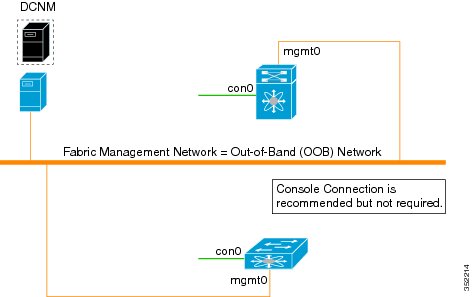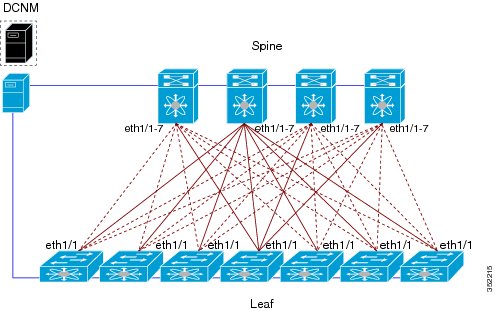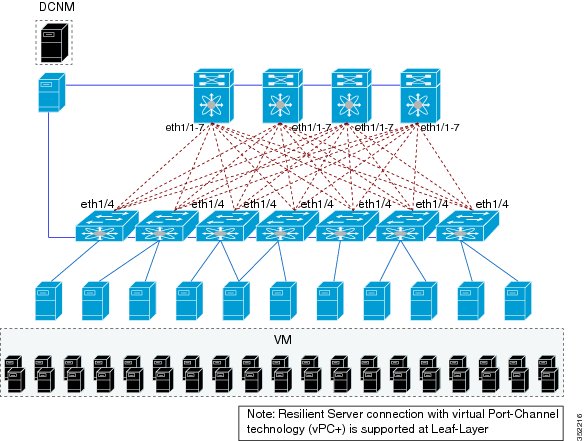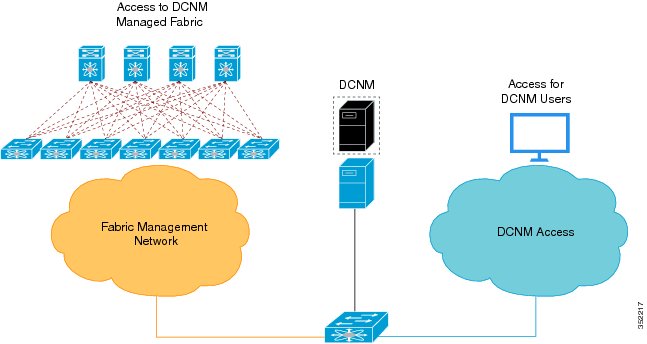

Contents
Deploying Cisco DFA
This section describes how to deploy Cisco Dynamic Fabric Automation (DFA).
This section includes the following topics:
- Platform Requirements
- Licensing Requirements for Cisco DFA
- Guidelines and Limitations for Cisco DFA
- How to Cable the Network Fabric and Servers for Cisco DFA
- Deploying Cisco DFA
Platform Requirements
Table 1 Cisco Dynamic Fabric Automation Platform Support Product Function Software Release (and later releases) Spine
Leaf
Border- Leaf
RR3 Other Cisco Nexus 6001 Series switch
Yes
Yes
Yes
Yes
Cisco NX-OS Release 7.0(0)N1(1)
Cisco Nexus 6004 Series switch
Yes
Yes
Yes
Yes
Cisco NX-OS Release 7.0(0)N1(1)
Cisco Nexus 7000 Series switch
--
--
Yes1
--
Cisco NX-OS Release 6.2(2)
Cisco Nexus 7700 Series switch
--
--
Yes1
--
Cisco NX-OS Release 6.2(2)
Cisco Nexus 1000V switch for VMware vSphere 5.1 and 5.5
--
--
--
--
Virtual switch with VDP signaling
Cisco NX-OS Release 4.2(1)SV2(2.2)
Cisco Prime Data Center Network Manager (DCNM)
--
--
--
--
Fabric management
Cisco Prime Data Center Network Manager Release 7.0
Cisco Prime Network Services Controller (NSC)
--
--
--
--
Services support
Release 3.2
OpenStack for Cisco DFA
--
--
--
--
(Optional)Controller
OpenStack for Cisco DFA 1.0
Licensing Requirements for Cisco DFA
Review the other hardware and software components of your existing fabric with respect to the Cisco Dynamic Fabric Automation (DFA) release requirements and compatibility constraints. Because Cisco DFA implements an architectural solution with a switch topology different from what you have previously used, devices may be required to perform different roles when used in a Cisco DFA implementation, and may be subject to new licensing requirements. For information, see the "Platform Requirements" section of this guide.
Guidelines and Limitations for Cisco DFA
Cisco Dynamic Fabric Automation (DFA) has the following guidelines and limitations:
- The fabric management network can support only one Dynamic Host Configuration Protocol (DHCP) server. You can use either the DHCP server in Cisco Prime Data Center Network Manager (DCNM) or another designated DHCP server, but not both.
- To ensure that Cisco DFA device auto configuration does not interfere with other DHCP servers on your network, we recommended that you use a dedicated VLAN and subnet for the fabric management network. Cisco Prime DCNM and the Ethernet out-of-band ports of the Cisco DFA switches (mgmt0) reside in the fabric management network. You have the option to interconnect the fabric management network with your existing out-of-band management network.
- The management connectivity for Cisco DFA must come through the Cisco NX-OS device management interface (mgmt0).
- The management port on any Cisco DFA switch must be connected to the same management subnet that includes the Cisco Prime DCNM user interface.
- Every Cisco DFA switch to be managed by fabric management must be connected to the fabric management network via the Ethernet out-of-band network.
- A console connection for fabric management is recommended but not required for Cisco DFA.
- If Cisco Prime DCNM is your repository server, you must upload the Cisco NX-OS kickstart and system-image images to Cisco Prime DCNM using the Serial Copy Protocol (SCP) or Secure File Transfer Protocol (SFTP).
How to Cable the Network Fabric and Servers for Cisco DFA
Fabric Connectivity
The fabric interfaces of the Cisco Dynamic fabric Automation (DFA) fabric connect the Cisco DFA switches to one another. Fabric interfaces are configured with Cisco FabricPath Frame Encapsulation (FE) for efficient forwarding based on a Shortest Path First (SPF) algorithm. You do not configure VLAN trunking or pruning for the transported VLANs on Cisco DFA fabric interfaces .
Server Connectivity
To transport data traffic across the Cisco Dynamic Fabric Automation (DFA) Fabric, the leaf switch must receive the traffic for connected VLANs that are to be extended across the fabric. The leaf-to-server interfaces are called host interfaces.
Note
Always connect servers to Cisco DFA leaf or border leaf switches. You must not connect servers to Cisco DFA spine switches.Deploying Cisco DFA
Note
If this is not a new Cisco DFA deployment, see the Cisco Dynamic Fabric Automation Migration Guide for migrating your existing fabric to a Cisco DFA deployment.
- Ensure that you have the appropriate Cisco Nexus devices with the minimum required Cisco NX-OS software releases to support Cisco Dynamic Fabric Automation DFA). See the "Platform requirements" section of this guide.
- Install the Data Center devices. For information, see the appropriate install guides for your Cisco Nexus devices.
Note
To deploy Cisco Prime DCNM, two port groups or port profiles are required on the virtual switch.
- Create a cabling plan and cable your Cisco Nexus devices for Cisco DFA. For information, see the "How to Cable the Network Fabric and Servers for Cisco DFA" section.
- Install the Cisco Prime Data Center Network Manager (DCNM) Open Virtual Appliance (OVA) to manage all the applications for the central point of management. For information, see the Cisco DCNM 7.0 OVA Installation Guide.
- Start the Prime NSM adapter in the Cisco Prime DCNM OVA and configure Services support for Cisco DFA. For information, see the "Network Services" section of the Cisco DCNM 7.0 OVA Installation Guide.
- (Optional) Use one of the following options to install OpenStack for Cisco DFA:
Note
- Before installing the Cisco OpenStack installer, the Cisco DFA fabric, switches, and Cisco Prime DCNM OVA must be already installed.
- To support OpenStack for Cisco DFA, Cisco Prime DCNM must be accessible via the OpenStack controller and the Cisco DFA fabric.

 Feedback
Feedback



